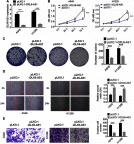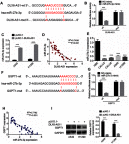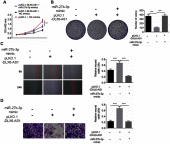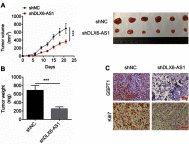LncRNA DLX6-AS1 promotes the proliferation, invasion, and migration of non-small cell lung cancer cells by targeting the miR-27b-3p/ GSPT1 axis
- PMID: 31190891
- PMCID: PMC6535439
- DOI: 10.2147/OTT.S196865
LncRNA DLX6-AS1 promotes the proliferation, invasion, and migration of non-small cell lung cancer cells by targeting the miR-27b-3p/ GSPT1 axis
Abstract
Background: Non-small cell lung cancer (NSCLC) has a significant impact on human health. The aim of this study was to explore the role of long non-coding RNA DLX6-AS1 in the proliferation, migration, and invasion of NSCLC cells. Methods: The expression of DLX6-AS1 in NSCLC tumor tissues and cell lines was examined by qRT-PCR. The effects of DLX6-AS1 knockdown on cell proliferation, migration, and invasion were assessed by Cell Counting Kit-8, wound healing, and transwell assays, respectively. Bioinformatics analyses, luciferase reporter assays, and RNA pull-down assays were employed to examine the mechanism by which DLX6-AS1 exerted its oncogenesis effects in NSCLC. The anti-tumor effect of silencing DLX6-AS1 in vivo was also evaluated. Results: DLX6-AS1 was over-expressed in NSCLC tumor tissues and cell lines and its level of expression was found to be associated with tumor size and advanced clinical stage in patients with NSCLC. Downregulation of DLX6-AS1 inhibited cell proliferation, cell clone formation, migration, and invasion of NSCLC cells. DLX6-AS1 was found to interact with miR-27b-3p/GSPT1. DLX6-AS1 expression was negatively correlated with miR-27b-3p expression, but positively correlated with GSPT1 expression in NSCLC samples. DLX6-AS1 knockdown also effectively suppressed tumor growth in an in vivo xenograft model. Conclusion: DLX6-AS1 regulated NSCLC progression by targeting the miR-27b-3p/GSPT1 axis, which may provide novel insights for NSCLC prognosis and therapy.
Keywords: DLX6-AS1; GSPT1; NSCLC; invasion; miR-27b-3p.
Conflict of interest statement
The authors report no conflicts of interest in this work.
Figures





Similar articles
-
DLX6-AS1: A Long Non-coding RNA With Oncogenic Features.Front Cell Dev Biol. 2022 Feb 25;10:746443. doi: 10.3389/fcell.2022.746443. eCollection 2022. Front Cell Dev Biol. 2022. PMID: 35281110 Free PMC article. Review.
-
Knockdown of lncRNA DLX6-AS1 inhibits cell proliferation, migration and invasion while promotes apoptosis by downregulating PRR11 expression and upregulating miR-144 in non-small cell lung cancer.Biomed Pharmacother. 2019 Jan;109:1851-1859. doi: 10.1016/j.biopha.2018.09.151. Epub 2018 Nov 26. Biomed Pharmacother. 2019. PMID: 30551440
-
Long non-coding RNA DLX6-AS1 knockdown suppresses the tumorigenesis and progression of non-small cell lung cancer through microRNA-16-5p/BMI1 axis.Transl Cancer Res. 2021 Aug;10(8):3772-3787. doi: 10.21037/tcr-21-1240. Transl Cancer Res. 2021. PMID: 35116677 Free PMC article.
-
LncRNA ZNFX1-AS1 targeting miR-193a-3p/SDC1 regulates cell proliferation, migration and invasion of bladder cancer cells.Eur Rev Med Pharmacol Sci. 2020 May;24(9):4719-4728. doi: 10.26355/eurrev_202005_21160. Eur Rev Med Pharmacol Sci. 2020. PMID: 32432735
-
Promising long noncoding RNA DLX6-AS1 in malignant tumors.Am J Transl Res. 2020 Dec 15;12(12):7682-7692. eCollection 2020. Am J Transl Res. 2020. PMID: 33437353 Free PMC article. Review.
Cited by
-
Strategies of LncRNA DLX6-AS1 on Study and Therapeutics.Front Genet. 2022 Jun 1;13:871988. doi: 10.3389/fgene.2022.871988. eCollection 2022. Front Genet. 2022. PMID: 35719380 Free PMC article. Review.
-
The Search for Molecular Markers in a Gene-Orphan Case Study of a Pediatric Spinal Cord Pilocytic Astrocytoma.Cancer Genomics Proteomics. 2020 Mar-Apr;17(2):117-130. doi: 10.21873/cgp.20172. Cancer Genomics Proteomics. 2020. PMID: 32108034 Free PMC article.
-
DLX6-AS1: A Long Non-coding RNA With Oncogenic Features.Front Cell Dev Biol. 2022 Feb 25;10:746443. doi: 10.3389/fcell.2022.746443. eCollection 2022. Front Cell Dev Biol. 2022. PMID: 35281110 Free PMC article. Review.
-
Comprehensive landscape and future perspective of long noncoding RNAs in non-small cell lung cancer: it takes a village.Mol Ther. 2023 Dec 6;31(12):3389-3413. doi: 10.1016/j.ymthe.2023.09.015. Epub 2023 Sep 21. Mol Ther. 2023. PMID: 37740493 Free PMC article. Review.
-
LncRNAs in Non-Small-Cell Lung Cancer.Noncoding RNA. 2020 Jun 30;6(3):25. doi: 10.3390/ncrna6030025. Noncoding RNA. 2020. PMID: 32629922 Free PMC article. Review.
References
LinkOut - more resources
Full Text Sources

